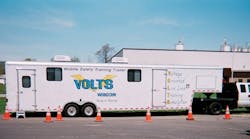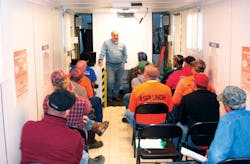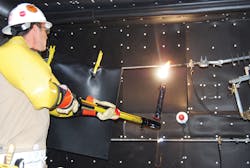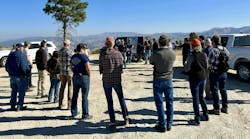Electric utilities depend on their internal or contract tree trimming crews to clear trees away from power lines and keep their rights-of-way clear from encroaching vegetation. While performing these services, tree trimmers are at risk for injuries from falling objects, falls, traffic, bee stings and snake bites.
One of the top hazards facing vegetation management crews, however, is electrical contact. To ensure that its tree crews are aware of these hazards, Asplundh Tree Expert Co. has created two mobile training units called Volts Wagons. The first one hit the road in 2006, and in recent years, utility personnel have been invited to attend the live-line demonstrations when the trailer is in their area.
While many utilities have live-line demonstration trailers, many of these units are small and designed to simply hold the educational materials. The trailers from Asplundh, however, are designed more like a mobile classroom. Everyone from a newly hired groundman to a utility forester can walk inside the climate-controlled trailers to gain a greater awareness of electrical hazards and view a live-line demonstration.
Teaching About the Dangers of Energized Lines
The live-line educational session takes about 1.5 hours and starts out with either a video or PowerPoint presentation that is available in both English and Spanish. Asplundh can tailor the presentation based on the audience. A streamlined presentation is available for shorter demonstrations given to utility personnel or members of the public.
The PowerPoint presentation shows different electrical components seen every day and explains the difference between direct and indirect contact. In addition, the attendees learn about volts, amps and ohms. As each slide flashes up on the screen, the instructor gives tips and advice on how the workers can stay safe in the field during vegetation management work.
The PowerPoint presentation also includes graphic real-life photos of victims of live-line contact, and many of these images drive home the point that energized lines present a true danger. Of course the instructors have the option of showing or not showing the images, depending on the audience present.
Following the slide or video presentation, the attendees experience a live-line demonstration. The trailer is built with an actual primary-neutral setup at the front of the trailer. A specially trained demonstrator then puts on all of the appropriate personal protective equipment like rubber gloves, sleeves, overshoes, safety glasses and a hard hat to work on the demonstration. Next, the demonstrator uses a hot stick, and as the line is energized, the group talks about how the voltage runs through the line and can be stepped down to a residential voltage through the use of a transformer. Then, a used tree climber’s rope is attached to the hot stick, and when it touches both the primary and the neutral, the electricity will spark and arc.
As part of this live demonstration, Asplundh also shows how a human body can be conductive of electricity. To show this concept, the Asplundh demonstrator sticks a hot dog inside the finger of a rubber glove and a conductive wire inside of the hot dog to simulate a bone. Next, he pricks a tiny pin hole on the end of the finger of the rubber glove and then places it on the end of a hot stick. When he touches the bottom of the wire to the neutral, it completes the entire circuit, and the electricity seeks the easiest path to ground. As a result, the hot dog goes up in smoke and flames.
“Electricity can find something as small as a pin hole in a rubber glove,” says Tracy Hawks, the training manager for Asplundh’s safety operations group. “We emphasize the importance of keeping tools clean and dry, having proper body positioning, staying at least the minimum approach distance from the line when it is energized and treating all lines as energized.”
While many of these concepts may not be new to linemen, they are invaluable lessons for the tree trimmers and other electric utility professionals who have not completed an apprenticeship in the line trade.
“Some linemen may have seen live-line contact in real life,” Hawks says. “But every lineman whom I’ve talked to said this trailer is a great educational tool for tree trimmers because they don’t have the experience with actual line work. It helps drive it home to the tree trimmers when the linemen say that they have to be careful around overhead lines. It may look like an innocent wire, but it can be very dangerous.”
Traveling Around the Country for Training
Vegetation management crews can be most susceptible to live-line contact when they remove branches from energized overhead wires following storms. They also can be at risk for touch or step potential when they touch anything that is conductive: a metal pole, fence or wet ground that is in contact with an energized wire that has been knocked down in a storm.
“All of our crews do storm work, and when the trees fall, someone has to get them off of the overhead lines,” Hawks says. “Understanding the hazards and how to avoid electrical contact can be a matter of life and death for our employees.”
Asplundh recently added a second trailer, and both of the mobile units travel around the country continuously. To make sure that as many employees as possible receive the training, Asplundh moves the trailer to different regions of the country. The Safety Operations Group trainers then train the regional instructors to operate the trailers and schedule the sessions. To stay current, the regional instructors must receive training once a year.
In the last year, the company has sent its trailers to more than 50 locations/utilities, and Asplundh has provided at least 500 sessions, including tree industry conferences and electric cooperative annual meetings as available.
“We move them around the entire country, and they keep busy the whole time,” Hawks says. “They never stay still for very long.”
Sometimes, the company will take the trailer to a state, and it will remain in that location for an entire month. The goal is to run all of the employees in the region through the trailer. They especially focus on educating the new employees who may not be aware of the danger of live lines. To help educate their non-lineman personnel, electric utilities have brought their managers and vegetation management teams to the trailers for live-line demonstrations.
For example, EnergyUnited, an electric cooperative in Statesville, North Carolina, has invited Asplundh to set up the Volts Wagon at its annual members’ meeting for several years.
“We try to raise safety awareness and educate our members about the potential problems with trees adjacent to power lines,” says Jimmy Brown, EnergyUnited’s director of maintenance. For several years now, Asplundh has been contracted to handle all of the cooperative’s outside tree work.
In the past, the cooperative also had its own live-line demonstration trailer, and it would bring in large power poles on a truck to local community groups to teach their members about the dangers of electricity. Over the last few years, however, the cooperative has opted to instead bring in Asplundh as well as Pike Electric to both do a demonstration. The vegetation management crews and the line crews work hand-in-hand in the field, and as such, EnergyUnited decided it would be more powerful for them to do a joint presentation.
“While the line crews build the lines and the tree crews trim the trees, we tied them together for our educational presentation,” Brown says. “The tree crews have a vital role of trimming the trees around the energized transmission and distribution lines because outages are just not acceptable. We also need to always remember the importance of safety while providing reliable electrical
service.”
This year, along with having Asplundh and Pike Electric educate its members about live-line hazards, EnergyUnited took advantage of the Volts Wagon’s recent stop in North Carolina to provide a demonstration for its internal employees. Various members of its office staff, dispatchers and call center representatives were able to attend one of 10 different training sessions held over four days in July and August.
“They are on the front line to answer members’ calls during the day about trees and safety surrounding power lines,” says Brown, who is responsible for vegetation and fleet management. “By educating our employees, they can communicate better with our members on a day-to-day basis.”
EnergyUnited employees have a wide range of skills and experiences, but the educational session proved especially invaluable for new dispatchers and office workers. For example, they learned how tree branches can conduct electricity, and how the tree and line crews are able to work around the energized lines. In addition, they learned what kind of personal protective equipment they must wear to have an extra layer of safety and protection.
“While it’s sometimes difficult for the field and office workforce to find time to pull away from their day-to-day responsibilities, it is important for them to learn as much as possible about live-line hazards,” Brown says.
Both cooperatives and municipalities that contract with Asplundh also have taken advantage of the trailer when it is in their region. By bringing the Volts Wagon to its internal crews and electric utility personnel whenever it is available, Asplundh is trying to minimize the risk of live-line contact and protect the lives of workers in the field.




